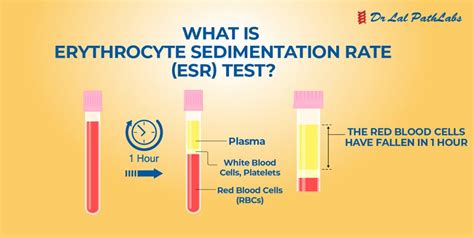Inflammation is a natural response of the body’s immune system, aimed at protecting it against harm, infection, or injury. However, chronic or excessive inflammation can lead to various health issues, including autoimmune diseases, cardiovascular diseases, and even cancer. One common lab test used to measure inflammation levels in the body is the Erythrocyte Sedimentation Rate (ESR) test. Understanding the ESR test and its implications can provide valuable insights into your health and help guide your healthcare provider in diagnosing and managing potential conditions.
What is the ESR Test?
The ESR test is a blood test that measures how quickly erythrocytes (red blood cells) settle at the bottom of a test tube containing a blood sample. It indirectly measures how much inflammation is in the body. The principle behind the test is that inflammatory states lead to the production of acute-phase proteins, which cause red blood cells to aggregate and settle more quickly. Therefore, a higher ESR indicates greater inflammation.
Why is the ESR Test Performed?
The ESR test is performed for several reasons, including: - Diagnosing and Monitoring Inflammatory Conditions: It can help in diagnosing conditions such as arthritis, vasculitis, or other inflammatory diseases and in monitoring the activity of these conditions over time. - Evaluating Symptoms: Symptoms like fever, fatigue, or weight loss that cannot be explained by other tests may prompt an ESR test to check for underlying inflammation. - Monitoring Response to Treatment: It can be used to assess how well the body responds to treatment for inflammatory conditions.
How is the ESR Test Performed?
Performing an ESR test is relatively straightforward: 1. Blood Sample Collection: A blood sample is drawn from a vein, usually in the arm. 2. Preparation: The blood sample is mixed with an anticoagulant to prevent clotting. 3. Measurement: The blood-anticoagulant mixture is placed in a tall, thin tube, and the rate at which the red blood cells settle is measured over a specified period, usually one hour. 4. Result Interpretation: The results are reported in millimeters per hour (mm/hr), indicating how much the red blood cell layer has descended in one hour.
Interpreting ESR Results
Understanding ESR results requires consideration of several factors, including age, sex, and the presence of any inflammatory conditions. Generally: - Normal Range: For adults, a normal sedimentation rate is usually considered to be 0 to 22 mm/hr for men and 0 to 29 mm/hr for women, though these ranges can vary slightly between laboratories. - Elevated ESR: An elevated ESR suggests the presence of inflammation but is not specific to any particular disease or condition. High levels may be seen in infections, autoimmune diseases, cancers, and other inflammatory conditions.
Limitations and Considerations
While the ESR test provides valuable information about the presence and possibly the extent of inflammation, it has several limitations: - Non-specificity: An elevated ESR is not specific to any condition and can be elevated in many different diseases and conditions. - Variability: Results can be influenced by various factors, including age, sex, and the presence of anemia. - Combination with Other Tests: For accurate diagnosis, ESR results are often considered alongside other clinical findings, patient history, and results of other diagnostic tests.
Managing Inflammation
If your ESR test indicates high levels of inflammation, managing it involves treating the underlying cause, which could include: - Medications: Such as nonsteroidal anti-inflammatory drugs (NSAIDs), corticosteroids, or disease-modifying antirheumatic drugs (DMARDs) for conditions like arthritis. - Lifestyle Changes: Including a balanced diet, regular exercise, quitting smoking, and reducing alcohol consumption. - Alternative Therapies: Some people find relief from inflammation through alternative therapies like acupuncture or herbal supplements, though it’s essential to discuss these with your healthcare provider.
Conclusion
The ESR test is a simple yet informative tool for assessing inflammation levels in the body. By understanding what the test measures, how it’s performed, and what the results imply, individuals can better appreciate the role of inflammation in their health and work closely with their healthcare providers to manage and reduce inflammation, potentially preventing long-term damage and improving overall well-being.
What does a high ESR indicate?
+A high ESR indicates the presence of inflammation in the body. It is a non-specific marker and can be elevated in various conditions, including infections, autoimmune diseases, and cancers. The exact cause of elevated ESR needs to be determined through further diagnostic tests and clinical evaluation.
Can ESR be used to monitor disease activity?
+Yes, ESR can be used to monitor the activity of certain diseases, especially inflammatory conditions like rheumatoid arthritis or lupus. A decrease in ESR often indicates a positive response to treatment, while an increase may suggest worsening disease activity or the need for a change in treatment strategy.
How often should ESR tests be performed?
+The frequency of performing ESR tests depends on the clinical context and the specific condition being monitored. For chronic inflammatory conditions, ESR may be checked regularly (e.g., every 3-6 months) to assess disease activity and response to treatment. The decision on how often to perform the test should be made by a healthcare provider based on individual patient needs.



